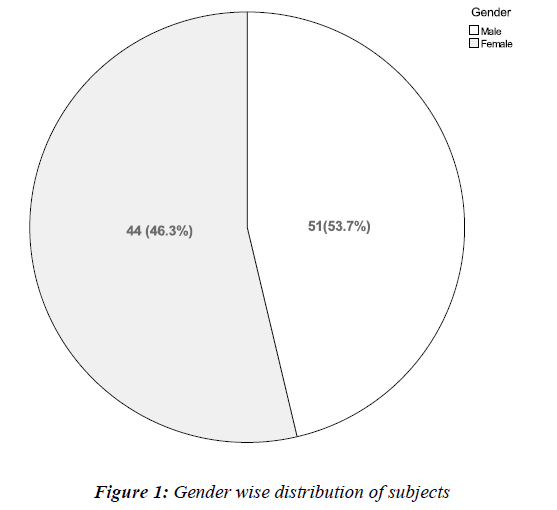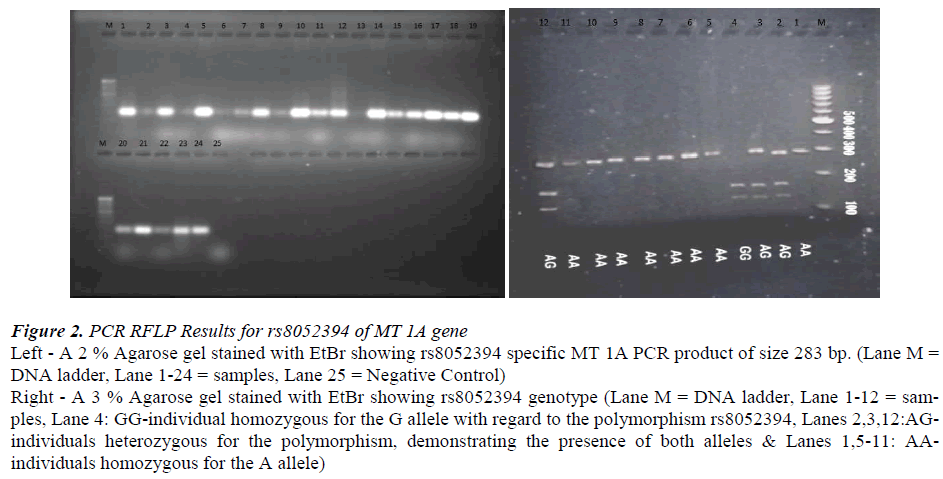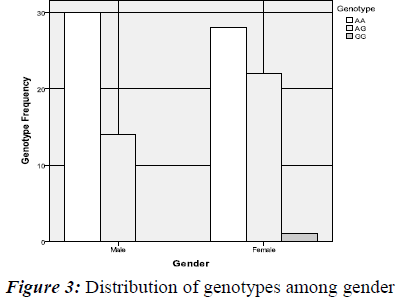ISSN: 0970-938X (Print) | 0976-1683 (Electronic)
Biomedical Research
An International Journal of Medical Sciences
- Biomedical Research (2013) Volume 24, Issue 1
Polymerase Chain Reaction - Restriction Fragment Length Polymorphism Analysis of nsSNP rs8052394 of Metallothionein 1A Gene.
Timilsina U1*, Singh KP2, Tamang HK3, Thapa S1
1Department of Biotechnology, College for Professional Studies, Kathmandu, Nepal.
2Department of Biochemistry, Maharajgunj Medical Campus (TUTH), Kathmandu, Nepal.
3Department of Biochemistry, Kantipur Dental College Teaching Hospital, Kathmandu, Nepal.
- *Corresponding Author:
- Uddhav Timilsina
Department of Biotechnology
College for Professional Studies
Kathmandu, Nepal
Email: timilsinau@gmail.coma
Accepted date: November 17 2012
This research is aimed at genotyping nsSNP rs8052394 in a cohort of Nepalese population using the Polymerase Chain Reaction – Restriction Fragment Length Polymorphism (PCR RFLP) technique. Metallothionein 1A (MT 1A) is a metal binding protein having properties like detoxification of heavy metals, homeostasis of essential metals including copper and zinc and antioxidation against reactive oxygen species. nsSNP rs8052394 (A→G transition) of MT1A shows decrease in the stability of the protein as analysed in silico by MuPro software. 95 subjects were randomly selected within Kathmandu valley. DNA was isolated from blood leukocytes. PCR RFCL technique was used to identify the genotypes. Genotype distribution was in accordance with Hardy-Weinberg Equilibrium (X2 =3.2237, df =1). ‘A’ allele frequency (p=0.79995) was higher than the mutated ‘G’ allele (q=0.20005) in the studied population. Genotype frequency distribution among Gender was not statistically significant (X2 = 2.344, df = 2, p value =0.310). Relatively higher prevalence of rs8052394 polymorphism among Nepalese population was found in this study. Further research on polymorphisms in MT 1A gene will be beneficial in indicating the association of this polymorphism with human health problems like cancer, diabetes, aging, metabolic syndrome and others.
Keywords
Nonsynonymus Single Nucleotide Polymorphism, Metallothionein, Polymerase Chain Reaction – Restriction Fragment Length Polymorphism
Introduction
Metallothioneins (MTs) are a group of ubiquitous lowmolecular- weight sulfhydryl and cysteine-rich proteins [1]. MTs have the capacity to bind both physiological (like zinc, copper, selenium) and xenobiotic (like cadmium, mercury, silver, arsenic) heavy metals [2]. In humans, MTs are synthesized in various organs (primarily in liver and kidneys) with varieties of isoforms (MT-1, MT- 2, MT-3, MT-4), encoded by a family of closely related genes which are located on chromosome 16q13. These main isomers are again subdivided as MT 1A, MT 1B, etc [3]. Production of MTs is dependent on availability of the dietary minerals- zinc and selenium, and the amino acidshistidine and cysteine present in the body [4]. This family of proteins functions in detoxification of heavy metals like mercury and cadmium, regulation of homeostasis of essential metals including copper and zinc, protection against varieties of oxidative stress, protection against DNA damage, cell survival, angiogenesis, apoptosis, as well as increase cell proliferation [5].
Association of genetic variations in MT 1A with human health problems has been studied a number of times [6- 13]. Nonsynonymus Single Nucleotide Polymorphism (nsSNP) rs8052394 of MT 1A Gene is the result of a nucleotide change A to G at position 55231329 of chromosome 16 reference assembly, and it results in the substitution of Lysine by Arginine at 51 position of the MET 1A protein (also called Lys51Arg polymorphism). This polymorphism shows decrease in the stability of the protein as analysed in silico by MuPro software [14]. Genotyping as well as the association of this SNP with human health problems has not been performed in Nepalese population till date as per our knowledge.
In this study we have identified the nsSNP rs8052394 by Polymerase Chain Reaction – Restriction Fragment Length Polymorphism (PCR-RFLP) technique and determined the allelic frequency of this polymorphism in Nepalese subjects by genotype counting.
Methods
3 ml of venous blood were withdrawn from 95 subjects within the age group of 20-80 years, randomly selected within Kathmandu valley with informed consent. The collected whole blood samples were stored at -20ºC till further processing. Molecular analysis was performed at Department of Biotechnology, College for Professional Studies, Maitidevi, Kathmandu, Nepal.
High molecular weight genomic DNA was extracted from blood cells by methodology as given by Lahiri et al., 1991[15]. Each extracted DNA samples were electrophorised on 1% agarose gel for an hour at 80-90 V on Tris Acetate EDTA (TAE) buffer system. Gels were stained with ethidium bromide (EtBr) and the DNA bands were observed under UV trans-illuminator. DNA extractions showing a single prominent band were processed for PCR amplification.
The PCR reaction was optimized for 200 ng of DNA. The primer pair selected was according to Ya Liu et al. 2008 [6] precisely amplifying the Lys51Arg specific fragment of MT 1A gene in the DNA sample. A 25μL PCR mixture was optimized containing 2.0 mM MgC12 (Fermentas), 0.4μM of each primer (Eurofins), 200μM of each deoxynucleotide triphosphate (Fermentas), 1.0 Unit of Taq polymerase (Genetix), and buffer concentration of 16mM (NH4)2SO4 and 67 mM Tris- HC1, pH 8.8. Two step PCR cycles were optimized- first step with initial denaturation at 95°C for 5 minutes followed by 35 cycles of denaturation at 95°C for 1 minutes, annealing at 55.7°C for 45 seconds and extension at 72°C for 45 seconds. This was followed by a final extension at 72°C for 7 minutes and a 4°C hold. Each PCR amplified products were electrophorized on 2% agarose gel along with 100 bp DNA ladder, run for 60 minutes at 80-90 V on TAE buffer system, stained with EtBr and observed under UV trans-illuminator. PCR products showing a single prominent band of 283 bp were processed for restriction digestion.
For RFLP analysis, 5 units of Pst I (Fermentas) were added to 10 μL of PCR product and incubated at 37°C for 3 hours followed by heat inactivation at 65°C for 20 minutes. Whole volume (15μl) of restriction digested products were loaded for gel electrophoresis on 3 % agarose gel along with 100 bp DNA ladder and run for 60 minutes at 80-90 V on TAE buffer system. Gels were stained with EtBr and the separated DNA bands were observed under UV trans-illuminator. Genotype distribution and Allelic frequency were calculated using PopGene.SÙ2(version 1.00) software. All the statistical analysis were done using IBM SPSS Statistics (version 19) software. All tests of statistical significance were two sided with 95% confidence intervals (CI).
Results
Among the total 95 subjects under study, 44 (46.3%) subjects were males while 51(53.7%) subjects were females. Their mean age was 49.91 ± 15.33 years (males : 50.27 ± 16.31 and females: 49.59 ± 14.58 years).
Figure 2: PCR RFLP Results for rs8052394 of MT 1A gene Left - A 2 % Agarose gel stained with EtBr showing rs8052394 specific MT 1A PCR product of size 283 bp. (Lane M = DNA ladder, Lane 1-24 = samples, Lane 25 = Negative Control) Right - A 3 % Agarose gel stained with EtBr showing rs8052394 genotype (Lane M = DNA ladder, Lane 1-12 = samples, Lane 4: GG-individual homozygous for the G allele with regard to the polymorphism rs8052394, Lanes 2,3,12:AGindividuals heterozygous for the polymorphism, demonstrating the presence of both alleles & Lanes 1,5-11: AAindividuals homozygous for the A allele)
After digestion of the 283 bp fragment obtained by PCR amplification, the three possible genotypes were distinguishable: homozygous GG (118, 165 bp), heterozygous GA (283, 165 and 118 bp), and homozygous AA (283 bp).
Table 1 shows the distribution of genotypes of nsSNP rs8052394 within the study population. Genotype count for homozygous AA allotype was the highest while a single count of homozygous GG allotype was found. Genotype distribution was in accordance with Hardy-Weinberg Equilibrium (X2=3.2237, DF=1). Genotype frequency distribution among Gender was not statistically significant as analyzed by Chi-square test (X2= 2.344, DF=2, p value =0.310). ‘A’ allele frequency (p=0.79995) was found to be high in Nepalese population compared to that of ‘G’ allele (q=0.20005).
Discussion
The purpose of this study was to determine the allelic frequency of nsSNP rs8052394 at the MT 1A gene in Nepalese population. The allele frequencies obtained for the Nepalese population, as well as those reported for other populations in the NCBIs SNP Database [16] are presented in Table 2. The ‘A’ allele in Nepalese population showed the least frequency of 0.799 and North American population sampled the maximum at 0.856. For ‘G’ allele it was 0.144 in North American population while ‘G’ allele frequency (0.201) was highest in Nepalese samples. The data was then analyzed for χ2 value to study difference in allele distribution among the Nepalese population and other populations of the world studied so far (Table 3). Statistically highly significant difference was observed on comparison with North American population while no significant difference was observed with East Asian population. Our findings indicated that nsSNP rs8052394 polymorphism is common in Asian populations.
The Lys51Arg polymorphism results in the substitution of Lysine for Arginine at 51 aminoacid position of MET 1A protein. This change may bring some conformational change leading to destabilization of the protein as predicted by MuPro web server. Ya Liu et al., 2008 showed a significant associations of MT 1A rs8052394 (G alteration) with Type 2 Diabetic Mellitus (T2DM) and decreased serum Superoxide Dismutase (SOD) activity. There were significant differences in SOD activity among AA, AG, and GG carriers in the diabetic patients, and the order of reduced SOD activity in the diabetic patients is GG, GA, and AA carriers. The enzyme SOD is an important antioxidant defense mechanism in almost all cells exposed to oxygen. Diabetes patients were found to predominantly overproduce superoxide and systemically impair antioxidant system, resulting in oxidative damage to multiple organs that play a critical role in initiating the pathogenesis of diabetic complications. There are two SODs activated by different metals (zinc/copper-SOD and manganese-SOD), and zinc/copper- SOD is a predominant component in cytosol. MT plays a critical role in the storage and homeostasis of zinc and copper; therefore, any abnormal expression of MT due to gene alterations may affect the supply of zinc and copper to enzymes such as zinc/copper-SOD in cells [6].
Zavras AI et al., 2011 showed that that subjects who are areca nut and tobacco users and are also MT 1A rs8052394 AA genotype carriers are at higher risk for oral squamous cell carcinoma (OSCC) development. According to them, the AA genotype may be associated with altered MT 1A’s ability to regulate the storage and homeostasis of zinc and copper. This abnormal expression may affect related molecules like p53, dependent on these metal supplies. The abnormal expression of MT 1A also may lead to continued oxidative stress and production of chronic inflammatory condition. Prolonged exposure to inflammatory cytokines is thought to induce oncogenesis via constitutive activation of the ras/mitogen-activated protein kinase (ras/MAPK) and phosphatidylinositol-3- kinase/Akt (PI3K/Akt) signaling pathways [7].
The limitations of our study include the fact that our cohort size is small restricting generalization of our findings. Furthermore, our study lacks the association of MT 1A rs8052394 with serum SOD activity. However, the reliability and biological importance of these findings should motivate further research to verify and extend them.
Conclusion
The study of genotype frequency distribution for the nsSNP rs8052394 in Nepalese population for the first time will definitely serve as a major achievement in understanding some complex disease states as diabetes, cancer, metabolic syndrome and aging resulting due to any interruption in the zinc hemostatis. In our study, we used PCR-RFLP method to determine the genotype frequency distribution which was reliable, rapid and cost-effective method. The Genotype frequency was in accordance with Hardy-Weinberg Equilibrium which suggested the suitability of sample size for the genotypic assays as well as the homogeneity of the concerned population. This study showed that the frequency of ‘G’ allele (q=0.20005) was highest in Nepalese population compared to other populations worldwide.
However further research is required to test the important hypothesis of either MT 1A variants could be considered as biomarker, alter toxicity and susceptibility of humans.
Acknowledgement
We will like to thank Management of College for Professional Studies, Kathmandu, Nepal for their assistance in performing this study.
References
- Margoshes M, Vallee BL: A cadmium protein from equine kidney cortex. J Am Chem Soc. 1957; 79: 4813-4814.
- Sigel A, Sigel H, Sigel RKO. Metallothioneins and Related Chelators. Metal Ions in Life Sciences. 2009,Cambridge: RSC Publishing. ISBN 978-1-84755-899-2.
- Le Beau MM, Diaz MO, Karin M, Rowley JD. Metallothionein gene cluster is split by chromosome 16 rearrangements in myelomonocytic leukaemia. Nature 1985; 313: 709-711.
- Thirumoorthy N, Shyam Sunder A, Manisenthil Kumar KT, Senthil Kumar M, Ganesh GNK and Chatterjee M. A Review of Metallothionein Isoforms and their Role in Pathophysiology. World J Surg Onc. 2011; 9: 54.
- Higashimoto M, Isoyama N, Ishibashi S, Inoue M,Takiguchi M, Suzuki S, Ohnishi Y, Sato M. Tissue dependent preventive effect of metallothionein against DNA damage in dyslipidemic mice under repeated stresses of fasting or restraint. Life Sci. 2009; 84:569-575.
- Yang L, Li H, Yu T, Zhao H, George CM, Cai L, and Liu Y. Polymorphisms in metallothionein-1 and -2 genes associated with the risk of type 2 diabetes mellitus and its complications. Am J Physiol Endocrinol Metab. 2008; 94: E987-E992.
- Zavras AI, Yoon AJ, Lin CW and Yang SF. Metallothionein- 1 Genotypes in the Risk of Oral Squamous Cell Carcinoma. Ann Surg Oncol. 2011; 18: 1478-1483.
- Cipriano C, Malavolta M, Costarelli L, Giacconi R, Muti E, Gasparini N, Cardelli M, Monti D, Mariani E, Mocchegiani E. Polymorphisms in MT1a gene coding region are associated with longevity in Italian Central female population. Biogerontology 2006; 7: 357-365.
- Giacconi R, Muti E, Malavolta M, Cipriano C, Costarelli L, Bernardini G, Gasparini N, Mariani E, Saba V, occoli G, Mocchegiani E. -838 C/G MT2A polymorphism, metals and inflammatory/immune response in carotid artery stenosis in elderly people. Mol Med. 2007; 13: 388-395.
- Sato M, Abe T, Tamai M. Analysis of the metallothionein gene in age-related macular degeneration. Jpn J Ophthalmol. 2000, 44: 115-121.
- Giacconi R, Cipriano C, Muti E, Costarelli L, Maurizio C, Saba V, Gasparini N, Malavolta M, Mocchegiani E.Novel 209A/G MT2A polymorphism in old patients with type 2 diabetes and atherosclerosis: relationship with inflammation (IL-6) and zinc. Biogerontology 2005; 6: 407-413.
- Mazzatti DJ, Malavolta M, White AJ, Costarelli L, Giacconi R, Muti E, Cipriano C, Powell JR, Mocchegiani E. Effects of interleukin-6 -174C/G and metallothionein 1A +647A/C single-nucleotide polymorphisms on incregulated gene expression in ageing. Exp Gerontol. 2008; 43(5): 423-432.
- Giacconi R, Kanoni S, Mecocci P, Malavolta M, Richter D, Pierpaoli S, Costarelli L, Cipriano C, Muti E, Mangialasche F, Piacenza F, Tesei S, Galeazzi R, Theodoraki EV, Lattanzio F, Dedoussis G, Mocchegiani E. Association of MT1A haplotype with cardiovascular disease and antioxidant enzyme defense in elderly Greek population: comparison with an Italian cohort. J Nutr Biochem 2010; 21(10): 1008-1014.
- http://www.ics.uci.edu/~baldig/mutation.html
- Lahiri DK and Nurnberger JI. A rapid non-enzymatic method for the preparation of HMW DNA from blood for RFLP studies. Nucleic Acids Res 1991, 19: 5444.
- http://www.ncbi.nlm.nih.gov/projects/SNP/snp_ref.cgi?rs=8052394.





